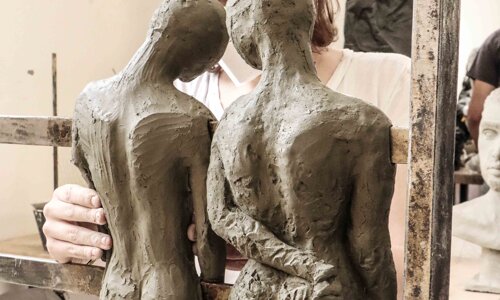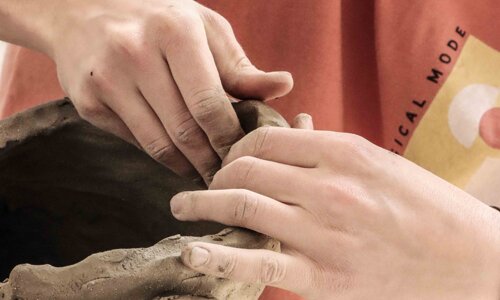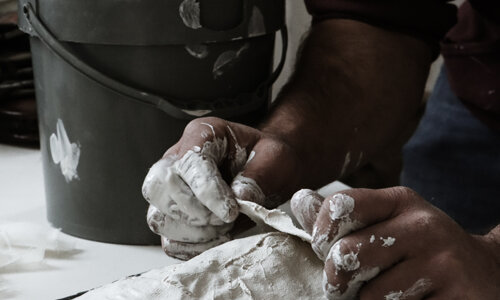Sculpture
Sculptor, environmental artist, sculpture restorer, digital modeler
Characteristics of the course of study
Technique and experimentation, innovation and individual research. The Sculpture course offers a comprehensive education that explores the world of sculpture through the use of various materials and techniques. This three-year program introduces students to contemporary sculpture, equipping them with all the cultural and technical elements essential to mastering sculptural materials—both traditional and innovative—for personal expressive purposes. In the third year of study, the curriculum is enhanced by 3D digital modeling, allowing contemporary sculptors to carry out the design phase more effectively and efficiently. Throughout the entire program, practical skills acquired through laboratory-based courses are enriched and made more productive by interaction with historical and theoretical teachings, which are fundamental for understanding the current artistic landscape.
Anno 1
-
Anatomia artistica
CFA Genere Docente 6 TP Guatta Giuliano Dettagli -
Disegno per la scultura
CFA Genere Docente 6 TP Fella Debora Dettagli -
Fotografia
CFA Genere Docente 6 TP Aliaj Erminando Dettagli -
Stile, storia dell'arte e costume
CFA Genere Docente 6 T Paderni Marisa Dettagli -
Scultura I
CFA Genere Docenti 8 L Branca Mario Modulo Dettagli Siragusa Rita Modulo Dettagli -
Linguaggi dell'arte contemporanea
CFA Genere Docente 6 T Zangrando Daniela Dettagli -
Pittura I
CFA Genere Docenti 8 L Bevilacqua Cinzia Modulo Dettagli Fella Debora Modulo Dettagli -
Storia del cinema e del video
CFA Genere Docente 6 T Asti Matteo Dettagli -
Fondamenti di informatica
CFA Genere Docente 6 TP Mutti Andrea Dettagli -
Inglese
CFA Genere Docente 4 TP Zanotti Beatrice Dettagli
Anno 2
-
Tecniche del marmo e delle pietre dure I
CFA Genere Docente 6 L Ricci Pietro Dettagli -
Storia dell'arte moderna B
CFA Genere Docente 6 T Azzoni Giorgio Riccardo Dettagli -
Storia dell'arte contemporanea I
CFA Genere Docente 6 T Sacchini Paolo Dettagli -
Tecniche dell'incisione calcografica
CFA Genere Docente 4 L Nakasone Keita Francesco Dettagli -
Scultura II
CFA Genere Docente 8 L Branca Mario Dettagli -
Formatura, tecnologia e tipologia dei materiali
CFA Genere Docente 8 TP Branca Mario Dettagli -
Tecniche per la scultura
CFA Genere Docente 8 TP Siragusa Rita Dettagli -
Economia e mercato dell'arte
CFA Genere Docenti 6 TP Canevazzi Vera Modulo Dettagli Remondina Camilla Modulo Dettagli -
Allestimento degli spazi espositivi
CFA Genere Docente 8 TP La Rosa Marco Dettagli
Anno 3
-
Tecniche del marmo e delle pietre dure II
CFA Genere Docente 6 L Ricci Pietro Dettagli -
Storia dell'arte contemporanea II
CFA Genere Docente 6 T Zangrando Daniela Dettagli -
Scultura III
CFA Genere Docente 8 L La Rosa Marco Dettagli -
Tecniche di fonderia
CFA Genere Docente 8 TP Branca Mario Dettagli -
Tecniche di modellazione digitale - Computer 3D I
CFA Genere Docente 6 TP Groppi Fabio Dettagli -
Tecniche e tecnologie delle arti visive
CFA Genere Docente 8 TP Pierobon Marta Dettagli -
Computer Art
CFA Genere Docente 4 TP Cadioli Marco Cesare Dettagli -
Tecniche plastiche contemporanee
CFA Genere Docente 6 TP Siragusa Rita Dettagli - Prova finale (CFA: 6)
Share
Professors
- Andrea Mutti
- Beatrice Zanotti
- Camilla Remondina
- Cinzia Bevilacqua
- Daniela Zangrando
- Debora Fella
- Erminando Aliaj
- Fabio Groppi
- Giorgio Riccardo Azzoni
- Giovanni Barboglio
- Giuliano Guatta
- Keita Francesco Nakasone
- Marco La Rosa
- Marco Cesare Cadioli
- Mario Branca
- Marisa Paderni
- Marta Pierobon
- Matteo Asti
- Pietro Ricci
- Rita Siragusa
- Vera Canevazzi
Course Goals
The Sculpture Course aims to provide artistic skills and knowledge focused on managing the expressive tools that underpin sculptural art (clay, plaster, marble, wood, iron), taking into account the plurality of languages, innovations in techniques, and the need for experimentation that the student will develop to structure their individual research. Graduates, thanks also to direct interaction with representatives of the "Art System" linked to the territory and the SantaGiulia Academy, will have the opportunity to participate in research projects and exhibitions in the fields of public art and visual arts. They will thus acquire foundational skills applicable on a professional level, enabling them to begin managing public and private commissions, relationships with gallery owners, and collaborations with artistic projects and groups.
Job perspectives
Sculptor, environmental artist, sculpture restorer, digital modeler
The professional profile of a graduate from the Sculpture Course is that of a visual artist proficient in sculptural expression techniques and capable of engaging with the dynamics of the art system and market. The sculptor will be able to work in the field of visual arts, in public or private settings, or as a freelance professional.


